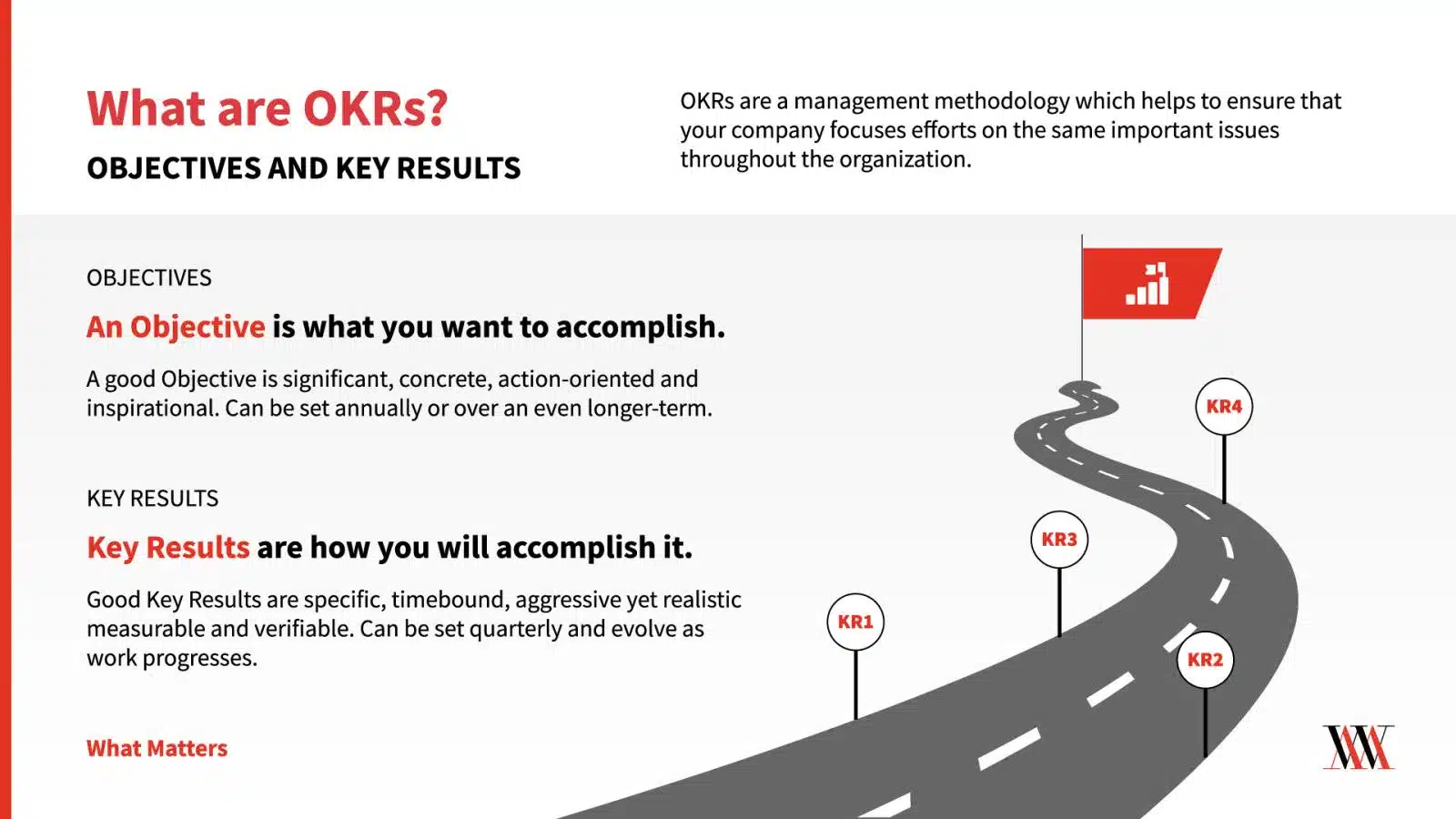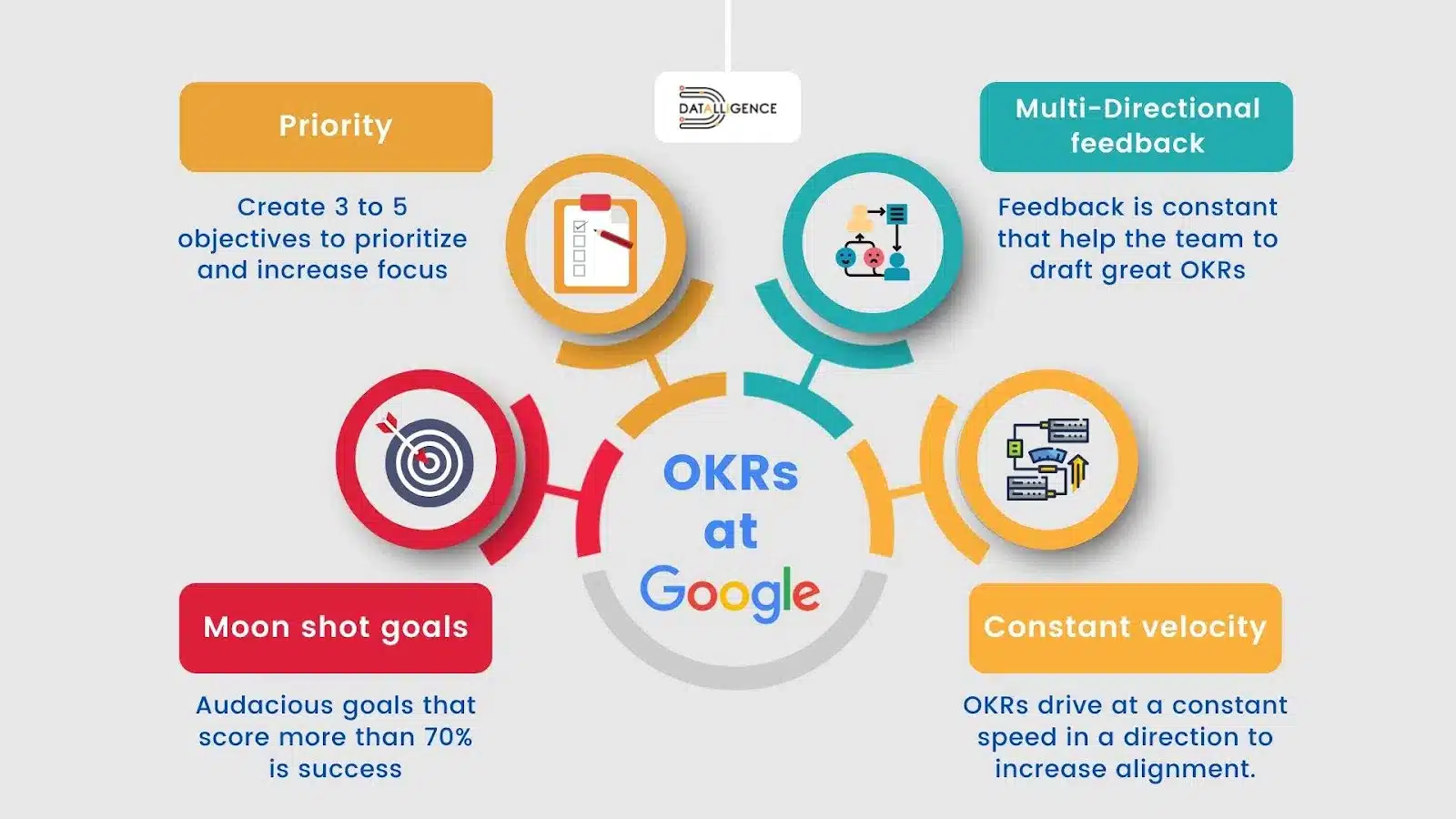The Objective and Key Results (OKR) model is a powerful way to align your organization’s strategy with its goal. It helps to achieve both mission and vision,enables faster strategy execution engagement, and helps determine the organization’s top priorities.
The roster of companies using it has already established the success of implementing OKR. Some popular examples include Google, Amazon, and Spotify.
But here’s the thing— building a goal-setting framework isn’t easy at first. In fact, 90% of businesses fail to reach their strategic goals because of poor implementation issues.
There are multiple steps involved in it. And in this article, we’ll discuss all of them but before jumping right into the steps, let’s talk about some basics.

What is OKR in an Organization?

OKR stands for “Objectives and Key Results.” It is a strategic goal-setting framework that is used by individuals, teams, and organizations to define and track objectives and their outcomes in a measurable and transparent manner.
In the OKR framework:
- Objectives are ambitious goals that express what you aim to achieve, providing direction and purpose.
- Key Results are measurable outcomes that track progress toward objectives, quantifying desired results for assessment.
OKRs are typically set for a specific time frame, often on a quarterly basis, and they encourage a balance between ambitious moonshot goals and achievable results
It functions as a dynamic and iterative process, characterized by regular check-ins and reviews that facilitate continuous alignment, evaluation, and adaptation. The process encourages proactive collaboration and communication across organizational tiers, engendering transparency and fostering a culture of accountability.
“One: set inspiring and measurable goals. Two: make sure you and your team are always making progress toward that desired end state. No matter how many other things are on your plate. And three: set a cadence that makes sure the group both remembers what they are trying to accomplish and holds each other accountable.”
-John Doerr, Book- Measure What Matters
But what makes a good OKR? Is there any format for that?

OKRs are flexible, which means, they can be adjusted per an organization’s goals and objectives. Once you establish your OKRs and you feel totally confident that you can achieve key results, then according to Atlassian, you should boost the target by 30%. However, if you think you won’t be able to achieve the KR, you already have set your sight high enough.
According to Google, the “sweet spot” for an OKR grade is 60% – 70%; if someone consistently fully attains their objectives, their OKRs aren’t ambitious enough and they need to think bigger. Low grades should be viewed as data to help modify the next OKRs.
Examples of Companies Using OKRs
While there are plenty of companies using OKRs, here are a few popular ones. You can take their example and apply the same framework to your organization.

Google has fostered a high-performing culture through the use of OKRs (Objectives and Key Results). These OKRs are central to the company’s operations, with all 70000 employees using them in their work. Google began using OKRs early on, even when the team was small, with just 40 members. The secret to their success lies in several factors:
- Clear, specific, and ambitious objectives that reduce risk.
- Transparency within the organization promotes autonomy and accountability.
- A focus on “Stretch Goals” that are set at a high standard (scoring 0-1, with a score of 1 indicating that the goal is not ambitious enough).
- A grading system that values excellent performance (70%-80% or a score of 7-8).
- And a focus on feedback and open communication about performance.
LinkedIn’s ex-CEO Jeff Weiner mentioned that OKRs are of personal value and it helps the team to stretch the goals with a proper plan and, finally, achieve them. Their success was mostly because of:
- Encouraging collaboration and teamwork.
- Providing support and resources to help team members achieve their OKRs.
- Holding regular check-ins to review progress and make adjustments as needed.
- Celebrating successes and recognizing individual and team achievements.
- Providing clear communication and transparency about the OKRs and their importance to the company’s overall success.
- Continuously evaluating and adjusting the OKRs to ensure they are aligned with the company’s overall strategy and goals.
YouTube
Susan Wojcicki and the YouTube team focused on innovation and experimentation, always looking for new ways to improve and grow the platform. They also focused on building a strong and diverse culture within the company, recognizing that a diverse team brings different perspectives and ideas to the table.
Overall, the combination of clear and measurable goals, innovation, and strong team culture has allowed YouTube to succeed tremendously and become a household name worldwide. Here’s what YouTube did to achieve success with an OKR framework:
- Set clear and measurable key results for each goal.
- Conducted regular check-ins and adjustments to ensure progress toward the goals.
- Promoted collaboration and transparency within the team to ensure everyone is aligned and working towards the same objectives.
What is an OKR Framework?
We’ve covered what OKRs are and how they can help organizations. Now let’s move on to what is an OKR framework.
OKRs have three key components— objectives, key results, and initiatives. Let’s understand these in detail.
Objectives
The OKR process begins with setting 3-5 key objectives at the organizational level. As a leader, it’s your responsibility to set an example and establish a rhythm for cascading these goals from your office to the OKRs of your teams. These objectives may be tailored to the roles and responsibilities of individual team members, but they should always align with the overall company objectives.
Some examples of objectives include-
- Reduce employee turnover and improve satisfaction.
- Launch a new product by a specific date.
- Increase product’s or service’s market share.
Key Results
In order to ensure the success of each identified objective, it is recommended to establish 3-4 measurable results or actions to take. This allows you, as a leader, to assess your employees’ progress and determine if they are working towards achieving their goals.
These results can be based on company revenue, employee satisfaction, growth, and performance. By assigning a numerical value to each key result, it becomes easier to track progress and identify areas that may still need improvement in achieving the company’s objectives.
Some examples of key results-
- Increase the website traffic by 200%.
- Boost the engagement rate on Facebook by 50%.
- Boost customer satisfaction rate by 25%.
Initiatives
Initiatives are the strategies or steps your organization would take to achieve the desired results. All such tasks should— be actionable. Be assigned to the right person, and come with a due date. Some examples of initiatives include-
- Running a paid campaign for a particular product or service.
- Creating a social media campaign.
- Improving the UX of the website to increase the conversion rate.
While there are many methods of setting OKRs, you need to find the method that suits your business needs. Here are the top three ways of setting up OKRs-
- Top-down: As the name suggests, in this method, the OKRs are set by senior management and then go down to lower-level employees.
- Bottom-up: In this method, the individuals set the OKRs as per their responsibilities and then seek approval from the top leadership.
- Hybrid: In this method, individuals and leadership are involved in setting up the OKRs.
The key to achieving success with OKRs is to review and modify goals time-to-time to ensure they are still relevant and achievable.
How to Develop a Goal-Setting OKR Framework?
Here’s how to develop a goal-setting framework for your OKRs-
Don’t Go for Cascading Goals
Using the cascading objectives method, the organization first sets its goals, followed by the goals of departments, teams, and individuals. The idea is that this helps individuals understand how their work contributes to the company’s overall objectives.
For instance, if the business wants to “retain customers,” the accounting department might set an objective to “maintain accurate customer records,” and an individual bookkeeper might set an objective to “send invoices on time, every time.”
However, this approach often leads to wasted time and misalignment of goals. Instead of teams taking charge and addressing their priorities, there is constant communication between leaders and individuals rather than proactive action.
Keep the Goals Simple
Having too many goals will confuse your priorities and hinder your ability to accomplish anything. Narrow down your objectives to a select few and concentrate your efforts on achieving your main objectives.
If you take on too much, you will likely fail to achieve your OKRs. OKRs are not meant to encompass every aspect of your business but to guide how you allocate your time and energy. For example, you can add a goal of improving the customer experience and then work on the strategies as well as decide on the desired result.
Be Very Specific
To set effective objectives, consider various methods for reaching the desired outcome. Create a detailed action plan that outlines the specific steps to achieve the objective. For each key result, consider how progress can be measured.
By being specific and clear in your objectives, you will clearly understand what needs to be done to reach your goals. For example, if you want to improve the organic traffic of your website, you should mention how much you want to increase it. It could be in percentage or a specific number.
Make your OKRs Measurable
To ensure that key results are accurately measured, it is important to include a unit of measurement. This could be anything from writing 20 blog posts per month to achieving $100,000 in revenue.
Including a measurement unit makes it clear whether a goal has been achieved or not. To add metrics to quantifiable goals, managers and employees can have 1:1 meetings to discuss and agree upon the measurements to be used.
Set Realistic Goals
Your goals should be both challenging and achievable. By setting realistic goals, you can be confident in reaching them while pushing yourself to improve and learn new skills. Don’t be afraid to set goals that require effort, as they can help you grow and develop. For example, you can aim for increasing the number of Facebook followers by 1000 by the end of the month.
Set Deadlines for Each Goal
To increase the chances that you will follow through with your objectives, establish clear and feasible deadlines for yourself. Write out deadlines for specific tasks after creating a list of them. For example, if your ultimate goal is to post ten blog posts in a month, one task could be to publish two posts by the end of the week. By setting a new publishing deadline each week, you can keep yourself accountable and track your progress toward achieving your goals.
OKR Software – Rated 4.8 on G2
Empower your managers to be a better leader with essential performance tools & personalized coaching support.
But will your organization get benefit from setting up OKRs?
Let’s explore!
Benefits of Goal Setting OKR Framework
According to an interview with Harvard Business Review, John Doerr said there are five key benefits of setting up OKRs. These benefits spell out the acronym “F.A.C.T.S.” which stands for
Focus
The first benefit of OKRs is their ability to focus on a limited number of objectives and key results. OKRs require upfront decision-making by limiting objectives to less than seven and key results to no more than five per objective. This ensures that only the most important initiatives are prioritized for the next three to twelve months.
By standing behind a few top-line OKRs, leaders can provide direction and a basis for evaluation for their team. Overall, the time-bound nature of OKRs sets them apart from other goal-setting systems and helps teams focus on making an immediate impact.
Alignment
After the main objectives have been determined, the actual work begins. As the team moves from planning to implementing their OKRs, everyone, including managers and contributors, aligns their daily tasks with the company’s overall vision.
This process, known as alignment, is crucial for success. Research from the Harvard Business Review has shown that companies with employees who are well-aligned are more than twice as likely to be top performers.
Commitment
After achieving focus and alignment, it is important to make commitments in the form of OKRs that have been agreed upon by all team members. These OKRs should be tracked transparently through a Google Sheet or an OKR tracking tool like BetterWorks. To ensure these commitments are met, schedules and resources may need to be adjusted. Each team member should provide clear signals that they are working towards their OKRs, whether through regular updates on all-hand slides, printing them out and posting them in the office, or using another method. The important thing is transparency and alignment in the tracking process.
Tracking
The popularity of management by objectives among top-tier companies is due to its ability to track OKRs from output to outcome. The metrics established when OKRs are written should allow for their tracking. While daily tracking is not necessary, it is important to conduct regular check-ups, preferably weekly, to prevent any decline in progress. These reference points allow individuals to evaluate their current OKRs and determine if they are on track to meet their objectives or if adjustments need to be made.
Stretching
Stretching beyond our limits is an integral part of the OKR process. As Larry Page of Google, a strong advocate for the concept of 10x-ing everything, once said, ‘I’d rather aim for Mars and end up on the moon than not try at all. This is how we make moonshots.’ According to John Doerr, OKRs encourage organizations to push themselves to achieve more than they believed was attainable.
Why Cascading OKRs is Bad for Your Startup in 2023
Download our ready-made goal-setting OKR framework
Conclusion
To thrive as a business. You must develop a plan; the first thing any plan would have is the SaaS OKRs. However, setting up OKRs by yourself can be intimidating. After all, you don’t want to overload your employees with work or underutilize their potential.
Here helps Peoplebox. Peoplebox is a leading OKR software that helps you execute strategies and accelerate your business growth by creating OKRs using its AI. Want to try? Request a demo today!







